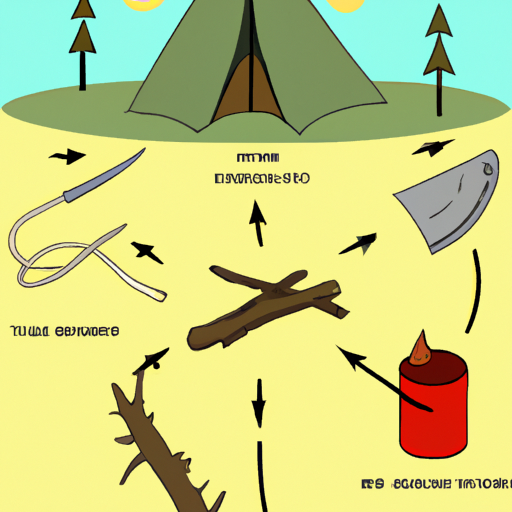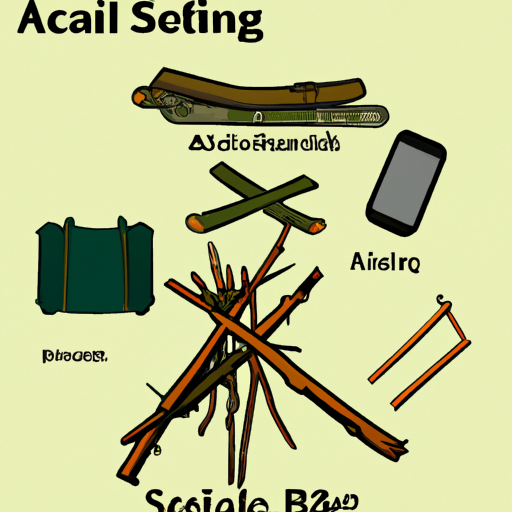Introduction
When you are out in the wilderness, it is important to have basic survival skills to ensure your safety and well-being. Knowing how to build a shelter, start a fire, find food, and navigate your way through the wilderness are all essential skills for anyone who plans to spend time outdoors. Having a basic understanding of these skills can help you stay safe and comfortable in the outdoors. In this article, we will discuss the basic survival skills needed for the outdoors, including shelter building, fire starting, food gathering, and navigation.
How to Build a Fire in the Wild: Tips and Techniques for Success
If you’re out in the wild and need to build a fire, you’ll want to make sure you do it right. Here are some tips and techniques to help you get the job done.
First, you’ll need to find a safe spot to build your fire. Look for an area that’s away from trees, brush, and other flammable materials. Make sure the area is clear of any debris that could catch fire.
Next, you’ll need to gather your materials. You’ll need tinder, kindling, and fuel. Tinder is the material that will catch fire first. This can be anything from dry leaves and grass to paper or bark. Kindling is the material that will help the fire grow. This can be small twigs, sticks, or even pine cones. Fuel is the material that will keep the fire going. This can be larger logs or branches.
Once you have your materials, you’ll need to create a fire bed. This is the area where you’ll build your fire. Clear away any debris and create a circle of stones or rocks to contain the fire.
Now it’s time to build your fire. Start by placing your tinder in the center of the fire bed. Then, add your kindling around the tinder in a teepee shape. Finally, add your fuel around the kindling.
Once your fire is built, you’ll need to light it. You can use a lighter, matches, or even a magnifying glass to get the fire started. Once the fire is lit, you can add more fuel as needed to keep it going.
Building a fire in the wild can be a challenging task, but with the right tips and techniques, you can do it successfully. Just remember to find a safe spot, gather your materials, create a fire bed, and light your fire. Good luck!
Essential Knots for Outdoor Survival: What You Need to Know
If you’re an outdoor enthusiast, you know that having the right knots in your back pocket can be a lifesaver. Knowing how to tie the right knots can help you secure your shelter, build a fire, and even save your life in an emergency. Here’s a quick guide to the essential knots you need to know for outdoor survival.
The Bowline Knot is one of the most important knots you can learn. It’s a strong, secure knot that can be used to tie a rope to a tree or post. It’s also great for creating a loop in the end of a rope, which can be used to secure a shelter or hang a hammock.
The Clove Hitch is another essential knot for outdoor survival. It’s a quick and easy knot that can be used to tie a rope to a tree or post. It’s also great for securing a tarp or tent to a tree.
The Square Knot is a versatile knot that can be used for a variety of tasks. It’s great for tying two ropes together, and it can also be used to secure a shelter or tarp.
The Prusik Knot is a great knot for creating a loop in the end of a rope. It’s great for tying a rope to a tree or post, and it can also be used to secure a shelter or tarp.
The Figure Eight Knot is a strong, secure knot that can be used to tie a rope to a tree or post. It’s also great for creating a loop in the end of a rope, which can be used to secure a shelter or hang a hammock.
Knowing how to tie these essential knots can help you stay safe and secure in the outdoors. So, take some time to practice these knots and make sure you’re prepared for any outdoor adventure.
Finding and Purifying Water in the Wild: What You Need to Know
If you’re planning a camping trip or a hike in the wilderness, it’s important to know how to find and purify water in the wild. After all, water is essential for survival, and you don’t want to be stuck without it. Here’s what you need to know.
First, you need to know how to find water. Look for signs of water, such as streams, rivers, ponds, and lakes. If you’re in a desert or other dry area, look for signs of life, such as birds or plants, which can indicate the presence of water. You can also look for depressions in the ground, which can be a sign of a water source.
Once you’ve found a water source, you need to purify it. Boiling is the most effective way to purify water, but it’s not always practical. If you don’t have a fire or a stove, you can use a water filter or purification tablets. These will remove bacteria and other contaminants from the water, making it safe to drink.
Finally, you should always be aware of the potential risks of drinking untreated water. Giardia and other waterborne illnesses can be contracted from drinking contaminated water, so it’s important to take the necessary precautions.
Finding and purifying water in the wild is an essential skill for any outdoor enthusiast. With the right knowledge and preparation, you can ensure that you have access to clean, safe drinking water wherever you go.
Building a Shelter in the Wild: What You Need to Know
If you’re planning on building a shelter in the wild, there are a few things you need to know. First, you need to make sure you have the right materials. You’ll need sturdy branches, logs, and other materials that can be used to construct a shelter. You’ll also need some kind of tarp or other waterproof material to cover the shelter.
Second, you need to make sure you have the right tools. You’ll need a saw, hammer, and nails to construct the shelter. You’ll also need a shovel to dig a trench around the shelter to keep out water.
Third, you need to make sure you have the right location. You’ll want to find a spot that is sheltered from the wind and rain, and that is close to a water source.
Finally, you need to make sure you have the right skills. Building a shelter in the wild is not something you can just do without any experience. You’ll need to know how to use the tools and materials, and you’ll need to be able to think on your feet and problem solve if something goes wrong.
Building a shelter in the wild can be a rewarding experience, but it’s important to make sure you’re prepared. Make sure you have the right materials, tools, location, and skills before you start building. Good luck!
Foraging for Food in the Wild: What You Need to Know
If you’re looking to get back to nature and forage for food in the wild, there are a few things you should know before you get started. Foraging for food can be a fun and rewarding experience, but it’s important to be aware of the risks and take the necessary precautions.
First, you should always be sure to identify the plants and mushrooms you’re foraging for. It’s important to know what you’re looking for and to be able to recognize it. There are many edible plants and mushrooms out there, but there are also many that are poisonous. It’s best to do your research and be sure you’re picking the right ones.
Second, you should always be aware of your surroundings. Make sure you’re not in an area that has been sprayed with pesticides or other chemicals. Also, be aware of any animals that may be in the area. You don’t want to startle any wild animals or put yourself in danger.
Finally, you should always practice good foraging etiquette. Don’t take more than you need and be sure to leave some for others. Also, be sure to clean up after yourself and leave the area as you found it.
Foraging for food in the wild can be a great way to get back to nature and enjoy the outdoors. Just be sure to do your research, be aware of your surroundings, and practice good foraging etiquette. With the right knowledge and precautions, you can have a safe and enjoyable experience.
Conclusion
In conclusion, basic survival skills are essential for anyone who plans to spend time outdoors. Knowing how to build a shelter, start a fire, find food and water, and navigate in the wilderness are all important skills that can help ensure a safe and enjoyable outdoor experience. With the right knowledge and preparation, anyone can be prepared for the outdoors.

